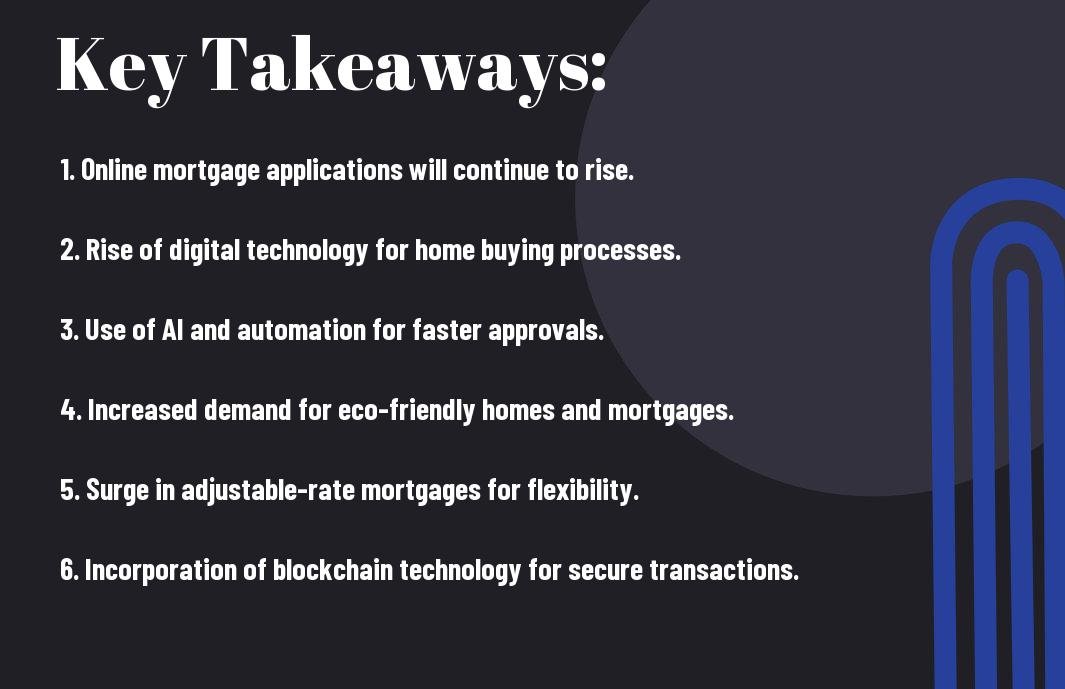Over the years, the housing market has seen significant shifts and innovations in mortgages. As we look ahead, it’s important to stay informed about the trends that will shape the future of this vital aspect of homeownership. Let’s explore the top 10 trends to keep an eye on in the evolving world of mortgages and the housing market.
Key Takeaways:
- Digital Transformation: The mortgage industry is undergoing a digital transformation, with online platforms offering simplified application processes and quicker approvals.
- Personalized Services: Lenders are increasingly focusing on offering personalized mortgage solutions tailored to individual financial situations and preferences.
- Changing Regulations: Keeping an eye on regulatory changes and trends in the housing market is crucial for both lenders and borrowers to adapt to shifting conditions.
Technology Integration
AI and Automation
If you’ve ever wondered about the future of mortgages, look no further than the rapid advancements in AI and automation. These technologies are revolutionizing the way lenders assess risk, process applications, and manage loan portfolios. By leveraging AI algorithms, lenders can streamline the underwriting process, reduce human error, and offer more personalized loan products to borrowers.
Blockchain Applications
Applications of blockchain in the mortgage industry are gaining momentum, offering enhanced security, transparency, and efficiency. Blockchain can help digitize and automate the verification process by securely storing and updating borrower information in real-time. This decentralized system reduces the risk of fraud, eliminates the need for multiple manual checks, and expedites the approval process for borrowers.

Alternative Financing
Crowdfunding Platforms
One innovative trend in the housing market is the emergence of crowdfunding platforms as a source of alternative financing for potential homebuyers. These platforms allow individuals to invest in real estate projects collectively, making it easier for new buyers to access funds for their dream homes.
Peer-to-Peer Lending
To address the changing landscape of mortgage financing, peer-to-peer lending has gained popularity as a viable alternative. Through online platforms, borrowers can connect with individual lenders willing to fund their home purchases. This method provides an alternative to traditional banks and offers more flexibility in terms of interest rates and repayment terms.
Now, borrowers can benefit from competitive rates and quick turnaround times with peer-to-peer lending for mortgages. These platforms are enabling a more streamlined process for securing financing, making homebuying more accessible to a broader range of individuals.
Any borrower looking to explore alternative financing options should consider peer-to-peer lending as a viable solution. With the potential for lower rates and less stringent requirements, this approach could be the key to unlocking your homeownership dreams.

Government Regulations
Changing Policies
You’ll notice that government regulations surrounding mortgages are constantly evolving. From adjusting interest rates to tightening lending criteria, these changes directly impact the housing market. Staying informed about these policies is crucial for both homebuyers and lenders to navigate the ever-changing landscape.
Affordability Initiatives
With a focus on making homeownership more attainable for a wider range of individuals, governments are introducing affordability initiatives. These can include programs offering down payment assistance, tax incentives for first-time buyers, or grants for energy-efficient home improvements. By taking advantage of these initiatives, more people can fulfill their dreams of owning a home.
Government policies play a significant role in shaping the housing market’s accessibility and stability. By implementing measures to promote affordability and responsible lending practices, they aim to create a marketplace that is fair and sustainable for all participants.
Green Mortgages
Once again, the housing market is seeing a shift towards more sustainable practices, and green mortgages are at the forefront of this movement. These innovative financial products are designed to encourage environmentally friendly choices in the real estate market.
Energy-Efficient Homes
Any homeowner looking to lower their carbon footprint and reduce their energy bills should consider investing in an energy-efficient home. These properties are equipped with features such as solar panels, energy-efficient appliances, and better insulation, making them more eco-friendly and cost-effective in the long run.
Sustainability Incentives
Mortgages that support sustainability incentives are gaining popularity among eco-conscious buyers. These incentives may include discounted interest rates, cash rebates for energy-efficient upgrades, or even financial rewards for meeting certain green certification standards.
The future of mortgages is leaning towards a more sustainable direction, and sustainability incentives play a crucial role in encouraging homeowners to make environmentally conscious choices. By offering financial rewards and benefits for energy-efficient practices, lenders are not only promoting a greener housing market but also helping homeowners save money in the process.
Remote Processes
Virtual Tours
There’s been a significant shift towards virtual tours in the real estate industry. Homebuyers can now explore properties from the comfort of their own homes, saving time and resources by narrowing down their options before physically visiting a property.
Online Transactions
Any mortgage process that can be done in person can now be done online, thanks to advancements in technology. From application submissions to document uploads and e-signatures, the entire mortgage process can be completed remotely, making it more convenient for both buyers and lenders.
It’s not just about convenience, but also about efficiency. Online transactions streamline the entire mortgage process, reducing paperwork and simplifying communication between all parties involved. Buyers can expect faster approvals and closings, while lenders can process applications more efficiently.
Big Data Analytics
Predictive Modeling
Analytics has revolutionized the mortgage industry with the use of predictive modeling. By analyzing vast amounts of data, lenders can now accurately predict trends and customer behavior, helping them make more informed decisions and reduce risk.
Personalized Offers
Clearly, one of the most exciting trends in the housing market is the rise of personalized offers in mortgages. Lenders are leveraging big data to create tailor-made loan options based on individual preferences and financial profiles.
With personalized offers, borrowers can now enjoy customized mortgage solutions that suit their specific needs and goals. This more personalized approach not only enhances the customer experience but also increases the likelihood of approval and satisfaction.
Changing Demographics
After years of traditional home buying patterns, the demographics of homebuyers are shifting, impacting the future of mortgages and the housing market.
Millennial Buyers
One of the key trends to watch in the housing market is the rise of millennial buyers. As this generation enters the home buying market, they bring with them new preferences and behaviors that will shape the future of mortgages.
Aging Population
Population aging is another demographic trend that will impact the housing market. As the population ages, there will be a growing need for housing that is accessible and adaptable to the needs of older adults.
It is important for mortgage lenders and real estate professionals to be aware of these demographic shifts and adjust their services and offerings to meet the changing needs of a diverse population of homebuyers.
Market Volatility
Economic Uncertainty
Keep an eye on economic uncertainty as it can greatly influence the housing market. Factors such as job security, inflation rates, and overall economic health can impact people’s ability and willingness to buy a home.
Interest Rate Fluctuations
One of the key trends to watch in the housing market is interest rate fluctuations. Changes in interest rates can affect the affordability of mortgages, influencing both the demand for homes and the overall health of the housing market.
Interest rates play a crucial role in determining the cost of borrowing for home buyers. Even a small increase or decrease in interest rates can have a significant impact on monthly mortgage payments and the overall cost of owning a home. It’s important for prospective buyers and current homeowners to stay informed about interest rate trends and be prepared to adjust their financial plans accordingly.
Urbanization Trends
City Living Demand
To meet the growing demand for city living, urban areas are seeing a rise in high-rise apartments, mixed-use developments, and compact living spaces. Residents are drawn to the convenience of city life, with access to amenities, entertainment, and employment opportunities all within close proximity.
Suburban Renewal
Assuming some homebuyers are seeking more space and a quieter lifestyle, suburbs are experiencing a resurgence in popularity. Some suburban areas are undergoing revitalization efforts, with the development of new shopping centers, green spaces, and community facilities, making them attractive alternatives to city living.
Some suburbs are also seeing an increase in demand for housing as remote work and telecommuting become more common, allowing individuals to live further away from city centers while still maintaining easy access to urban amenities.
Any investors looking to capitalize on the suburban renewal trend should consider purchasing properties in up-and-coming suburban neighborhoods that offer a mix of affordability and quality of life to attract potential buyers.
Conclusion
Now is an exciting time in the housing market as we see new trends emerging in the future of mortgages. From digital innovations to changing consumer preferences, it is important for both lenders and borrowers to stay informed and adapt to these trends. By staying ahead of the curve and embracing technology, we can look forward to a more streamlined, efficient, and inclusive mortgage process in the years to come.
